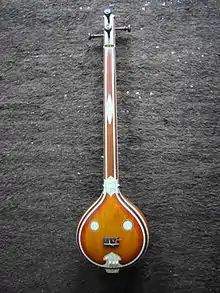Malahari
Malahari is a Carnatic raga. This raaga is a janya of the 15th Melakarta raga Mayamalavagowla. This raga is known to be a morning raga which brings out a sense of calmness.[1] It is associated with the rainy season.[2]
| Arohanam | S R₁ M₁ P D₁ Ṡ |
|---|---|
| Avarohanam | Ṡ D₁ P M₁ G₃ R₁ S |
| Carnatic music |
|---|
 |
| Concepts |
| Compositions |
| Instruments |
|
In classical carnatic training, it is often used as a raaga for beginners using geetha right after the swara-based exercises in Mayamalavagowla. Many of the Geetha's in this raga have been composed by Purandara Dasa and Muthuswami Dikshitar.

Structure and Lakshana

This raga is an asymmetric scale and is classified as an audava-shadava raga (five notes in the ascending scale and six notes in the descending scale).[1][2]
- ārohaṇa: S R₁ M₁ P D₁ Ṡ[lower-alpha 1]
- avarohaṇa: Ṡ D₁ P M₁ G₃ R₁ S[lower-alpha 2]
The notes in this scale are shuddha rishabha, shuddha madhyama, shuddha dhaivata in arohana and additional antara gandhara in avarohana. Since this scale does not have a nishadha, it can be derived from Gayakapriya (13th melakarta) or Vakulabharanam (14th) too, but has been traditionally associated with Mayamalavagowla (15th) as the parent.
Select compositions
Geeta's
- shri GaNanaatha in Rupaka, written by Purandara Dasa
- kunda gowra gowrivara in Rupaka, written by Purandara Dasa
- padumanaabha paramapurusha in Triputa, written by Purandara Dasa
- kereya neeranu kerege chelli in Triputa, written by Purandara Dasa
Kritis
- Panchamatanga in Rupaka composed by Muthuswami Dikshitar
- Ananta Padmanaabam in Rupaka composed by Muthiah Bhagavatar
- Kalaye Devadeva in Jhampa composed by MaharajaSwathi Thirunal
- Melukovayya in Adi composed by Shahji Maharaja
Related rāga's
This section covers the theoretical and scientific aspect of this rāga.
Scale similarities
- Karnataka Shuddha Saveri is a rāga which has a symmetrical scale matching the ascending scale of Malahari (gandhara is entirely omitted). Its ārohaṇa-avarohaṇa structure is S R1 M1 P D1 S : S D1 P M1 R1 S
Notes
- Alternate notations:
- Hindustani: S Ṟ M P Ḏ Ṡ
- Western: C D♭ F G A♭ C
- Alternate notations:
- Hindustani: Ṡ Ḏ P M G Ṟ S
- Western: C A♭ G F E D♭ C
References
- Raganidhi by P. Subba Rao, Pub. 1964, The Music Academy of Madras
- Ragas in Carnatic music by Dr. S. Bhagyalekshmy, Pub. 1990, CBH Publications